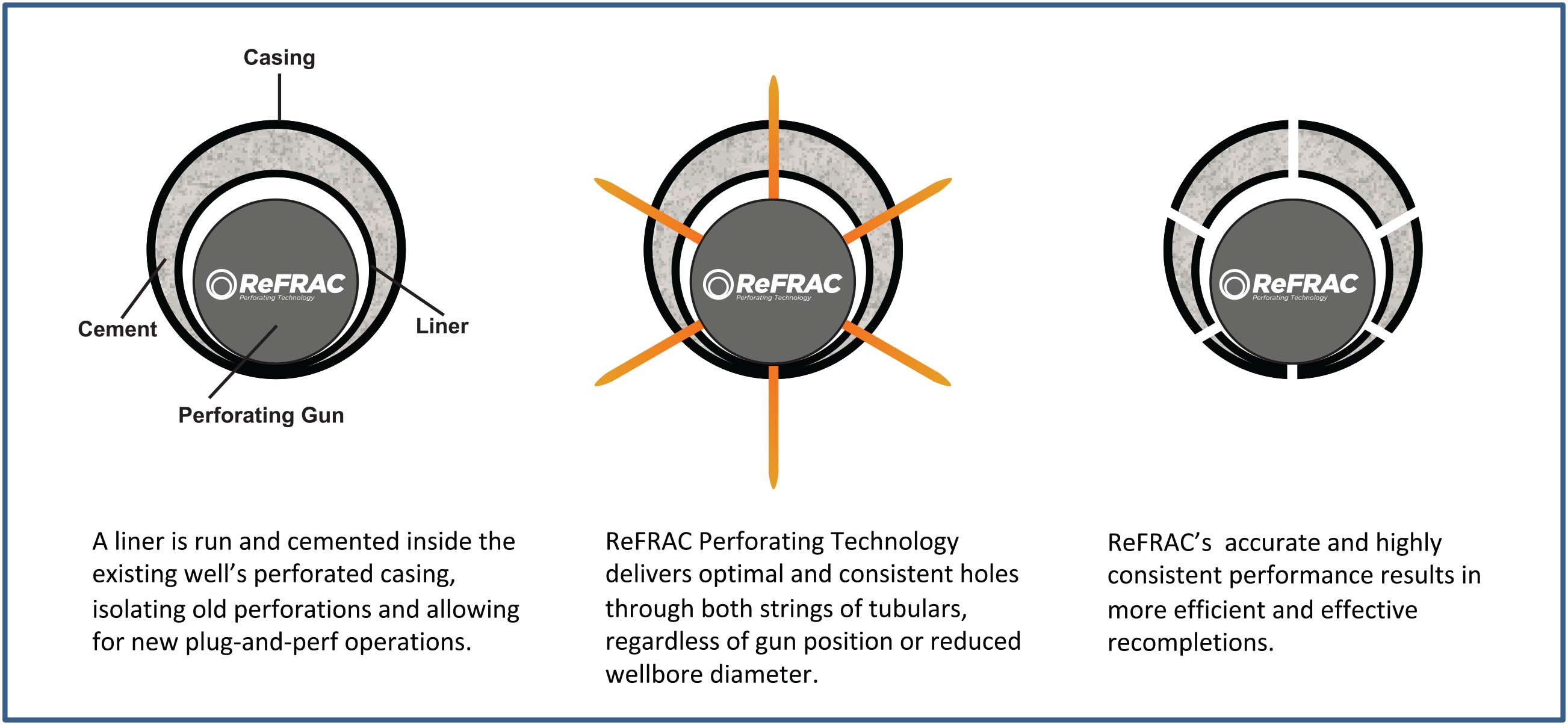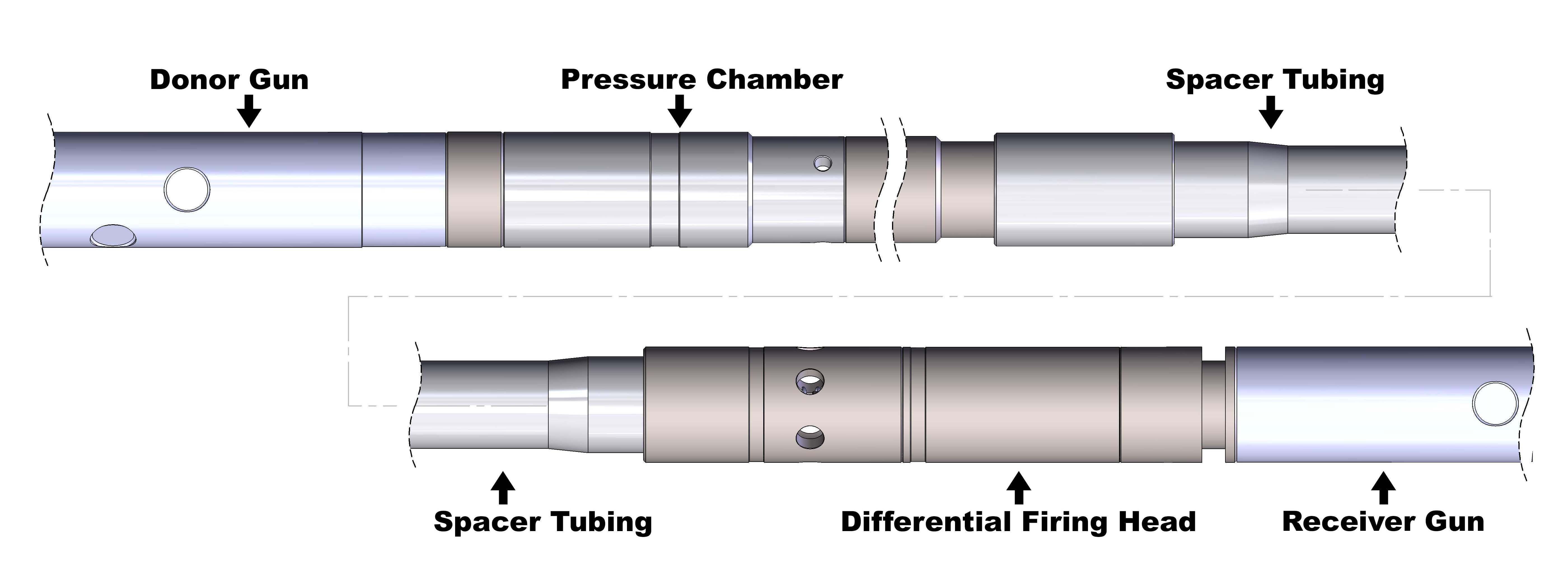Technological innovation and new ideas have been at the forefront of the oil industry since its inception. There were more than 4,600 rigs drilling in the U.S. in 1986 supplying oil and gas needs. Today there are less than 1,000 rigs drilling, and the U.S. is once again the worldwide leader in production.
Recompletion of wells already drilled has always been an industry practice. However, with the innovation of horizontal drilling and associated fracturing techniques, recompletion practices have new technology challenges needing solutions.
Bullhead refracturing and mechanical isolation refracturing are two recompletion techniques currently being used. The fundamental problem was how to convey perforating guns in wells that had already been perforated and how to achieve equivalent hole size perforations in multiple casing strings. Core Laboratories/Owen Oil Tools have released the Pulse Wave Perforating and ReFRAC Perforating Technology systems to address these challenges.

Bullhead fracs
If the refrac technique uses a bullhead diverter or a straddle packer method, requiring new perforations to be added between the existing perforations, the previously completed wellbore limits the use of most of the various perforating methods used during the initial completion. Because of existing perforations, wireline pumpdown is not an option to add new perforations for the refrac as the perforating guns can only be pumped down to the top set of perforations or the first set of perforations accepting fluid. Deploying wireline guns on a tractor is another practice, though tractors can be problematic when passing through open perforations.
Tubing-conveyed perforating (TCP) has been used on many horizontal wells. When deploying guns via TCP on a workover rig in a new well, a pressure-actuated firing head is installed on every gun. The firing heads are usually set to activate at different pressures, thus firing the perforating guns at different times. This method requires wellbore integrity (no perforations) so the well can be pressured up (normally down the annulus) to activate the firing heads. This method is not an option when adding new perforations as the wellbore cannot be pressured up because of existing perforations.
TCP guns also can be deployed on coiled tubing (CT) utilizing a time delay fuse between each gun. When adding new perforations to an entire wellbore for refracturing, the number of guns run on one trip using CT is limited to the height of the lubricator. This restriction can facilitate multiple runs on CT to accomplish all the new perforating clusters desired for the refrac.
The Pulse Wave Perforating system is a TCP method to add new perforations to the existing wellbore allowing an unlimited number of perforating guns to be run in one single trip across multiple zones and stages. A pressure chamber is attached to the bottom of each perforating gun and a differential firing head is attached to the top of each gun. Tubing is installed between each gun giving the desired distance between the perforating guns.
The top gun is detonated with a ball-drop firing head, which isolates pressure in the tubing until detonation. Upon detonation, a pressure pulse is created in the pressure chamber and is transmitted down the spacer tubing. When the pressure pulse reaches the differential firing head on the next gun, this gun is detonated creating another pressure pulse that is sent to the next perforating gun in succession. This process is repeated until all perforating guns in the assembly are detonated.
To date, numerous wells have used more than 100 Pulse Wave Perforating systems with 100% success. Advantages include the ability to perforate horizontal wells with existing perforations and perforate all clusters in one trip. In addition, guns are spaced exactly when fired, and the systems are cost-effective by eliminating time delay fuses and CT runs. Time savings in completing the well allows quicker time to production.

Mechanical isolation
Another refracturing technique growing rapidly in the industry is known as a mechanical isolation recompletion. In mechanical isolation recompletions, a liner is cemented inside the existing well’s perforated casing, isolating old perforations and allowing for new plug-and-perf operations. While this recompletion technique provides the operator with several advantages, it creates a new set of challenges for perforating that can negatively impact fracturing operations and production.
The liner reduces the wellbore inside diameter, which requires a smaller diameter perforating gun to be run than what is typically used in new completions. The smaller diameter perforating gun also means the limitation of using a smaller shaped charge with less explosive weight.
In addition, there is also the challenge of shooting through a liner, cement and then the existing well casing. Typically the liner is eccentric in the existing well casing and the gun is eccentric in the liner, further complicating the goal of producing optimal and consistent hole sizes around the circumference of both strings of tubulars.
Modern-day perforating charges, including charges designed to deliver consistent hole sizes through a single string of casing new completions, produce small and inconsistent hole sizes when shot through two strings of tubulars in the mechanical isolation scenario. While it is possible to hydraulically fracture through the smaller holes, perforation friction is high, pump rates are low, time per stage is excessive and results are less than optimal.
Core Laboratories partnered with one of the world’s largest independent E&P companies to design and develop a perforating system specifically for mechanical isolation type recompletions. This new perforating technology is engineered to deliver optimal and consistent holes through both strings of tubulars, regardless of gun position, allowing new zones within existing laterals to be effectively stimulated.
To date, numerous wells using the new technology have been successfully recompleted in both the Eagle Ford and Bakken by multiple operators. The companies have reported completing up to double the number of stages per day over other modern-day perforating systems. The companies also have seen consistent and reliable fracs from stage to stage and well to well in addition to encouraging production results.
This technology helps completion teams enhance return on investment by minimizing risks, reducing time and costs, and maximizing stimulated reserve volume.
Conclusion
As production on unconventional wells declines, operating companies are challenged to revitalize these assets through recompletion or refrac methods rather than drill a new well. Bullhead diverter and mechanical isolation are two new techniques being used to answer this challenge, and the Pulse Wave Perforating and ReFRAC charges are two recent systems helping to achieve these goals.
Recommended Reading
BP Restructures, Reduces Executive Team to 10
2024-04-18 - BP said the organizational changes will reduce duplication and reporting line complexity.
Matador Resources Announces Quarterly Cash Dividend
2024-04-18 - Matador Resources’ dividend is payable on June 7 to shareholders of record by May 17.
EQT Declares Quarterly Dividend
2024-04-18 - EQT Corp.’s dividend is payable June 1 to shareholders of record by May 8.
Daniel Berenbaum Joins Bloom Energy as CFO
2024-04-17 - Berenbaum succeeds CFO Greg Cameron, who is staying with Bloom until mid-May to facilitate the transition.
Equinor Releases Overview of Share Buyback Program
2024-04-17 - Equinor said the maximum shares to be repurchased is 16.8 million, of which up to 7.4 million shares can be acquired until May 15 and up to 9.4 million shares until Jan. 15, 2025 — the program’s end date.





